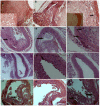β-Carotene Attenuates Angiotensin II-Induced Aortic Aneurysm by Alleviating Macrophage Recruitment in Apoe(-/-) Mice
- PMID: 23826202
- PMCID: PMC3694956
- DOI: 10.1371/journal.pone.0067098
β-Carotene Attenuates Angiotensin II-Induced Aortic Aneurysm by Alleviating Macrophage Recruitment in Apoe(-/-) Mice
Abstract
Abdominal aortic aneurysm (AAA) is a common chronic degenerative disease characterized by progressive aortic dilation and rupture. The mechanisms underlying the role of α-tocopherol and β-carotene on AAA have not been comprehensively assessed. We investigated if α-tocopherol and β-carotene supplementation could attenuate AAA, and studied the underlying mechanisms utilized by the antioxidants to alleviate AAA. Four-months-old Apoe(-/-) mice were used in the induction of aneurysm by infusion of angiotensin II (Ang II), and were orally administered with α-tocopherol and β-carotene enriched diet for 60 days. Significant increase of LDL, cholesterol, triglycerides and circulating inflammatory cells was observed in the Ang II-treated animals, and gene expression studies showed that ICAM-1, VCAM-1, MCP-1, M-CSF, MMP-2, MMP-9 and MMP-12 were upregulated in the aorta of aneurysm-induced mice. Extensive plaques, aneurysm and diffusion of inflammatory cells into the tunica intima were also noticed. The size of aorta was significantly (P = 0.0002) increased (2.24±0.20 mm) in the aneurysm-induced animals as compared to control mice (1.17±0.06 mm). Interestingly, β-carotene dramatically controlled the diffusion of macrophages into the aortic tunica intima, and circulation. It also dissolved the formation of atheromatous plaque. Further, β-carotene significantly decreased the aortic diameter (1.33±0.12 mm) in the aneurysm-induced mice (β-carotene, P = 0.0002). It also downregulated ICAM-1, VCAM-1, MCP-1, M-CSF, MMP-2, MMP-9, MMP-12, PPAR-α and PPAR-γ following treatment. Hence, dietary supplementation of β-carotene may have a protective function against Ang II-induced AAA by ameliorating macrophage recruitment in Apoe(-/-) mice.
Conflict of interest statement
Figures









References
-
- Nakahashi TK, Hoshina K, Tsao PS, Sho E, Sho M, et al. (2002) Flow loading induces macrophage antioxidative gene expression in experimental aneurysms. Arterioscler Thromb Vasc Biol 22: 2017–2022. - PubMed
-
- Shimizu K, Mitchell RN, Libby P (2006) Inflammation and cellular immune responses in abdominal aortic aneurysms. Arterioscler Thromb Vasc Biol 26: 987–994. - PubMed
Publication types
MeSH terms
Substances
LinkOut - more resources
Full Text Sources
Other Literature Sources
Medical
Research Materials
Miscellaneous

